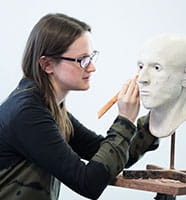Design for Dementia
Architecture, design and dementia
Can architecture and design help people with dementia?
Design for Dementia is an ongoing integrated research, design and build project.
Project title
Design for Dementia: The International Challenges and Architectural Responses
Context
- Between 70% and 80% of people with dementia live in their own homes
- The projected growth in households up to 2033, indicates a proportion of the population will be over 65 years old
- Dementia is considered one of the 21st century’s international health care challenges
- It is estimated that across the world someone will be diagnosed with a type of dementia every four seconds
Aim of Design for Dementia
As most people experiencing dementia wish to remain at home, the design and construction of new dwellings or home conversions are paramount. To address issues arising from the pressures associated with dementia, design solutions need to be integrated within our architecture, environment and the landscape.
Alongside Halsall Lloyd Practice of architects, landscape architects, urban designers and graphic designers, academics from the Institute of Art and Technology aim to research whether architecture and the design of the environment can assist people to “live better with dementia”.
Overall, the team plan to establish new architectural standards for design for dementia. The team also aim to produce an Architectural, Environmental and Urban Design Manual about Dementia Friendly Neighbourhoods and Dwellings. The manual will be for users and professionals and will be based upon international best practice.
The Design for Dementia project
To address these real-world issues, in 2015 Dr Rob MacDonald and Bill Halsall published two volumes of Design for Dementia. The work received positive feedback from both users and GPs.
The next phase of the project, which is set to last three years and began in 2016, is to examine international examples of design for dementia, from Switzerland to Japan. Case study visits will include architectural, special, landscape, contextual, sociological and photographic studies. Desktop and virtual studies will also be undertaken.
Real-world impact
Design for Dementia has real-world impact for multiple groups. For individuals, quality of life will improve. For the Government, savings can be made within health and social services. In addition to this, the issues being addressed by the academics are international issues. Consequently, the research has already attracted interest from other parts of the world.
Collaboration
Academics from the Institute of Art and Technology work with a variety of stakeholders, including:
- Halsall Lloyd Practice of architects
- landscape architects
- urban designers
- graphic designers
- Intereg New
- Innovate Dementia
- Mersey Care NHS Trust
- DAA Dementia Action Alliance
Funding
Funding has been provided by the following:
- The Design for Dementia project was awarded the 2016 RIBA Research Award
- MerseyCare Trust
- Health Sciences LJMU
- HL Partnership Graphic Design and Printing
- Sundry Research Visits to Watford and Ravenscraig Glasgow
Building Research Establishment (BRE) are raising £650,000 to build The Dementia Dwelling at their Watford Innovation Park.





